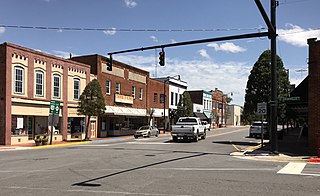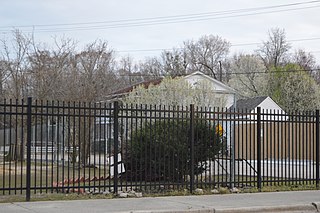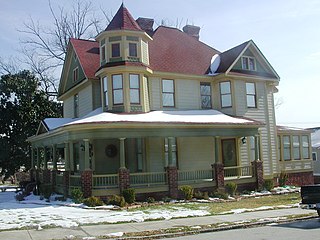
Windsor is a town in Bertie County, North Carolina, United States. The population was 3,630 at the 2010 census, up from 2,283 at the 2000 census. It is the county seat of Bertie County, which is also the homeland of the Southern Band Tuscarora Tribe that remained in NC post Colonialism. Windsor is located in North Carolina's Inner Banks region.

Green Level is an unincorporated community near the town of Cary in southwestern Wake County, North Carolina, United States. It was founded around 1800, and is one of the oldest surviving crossroads communities in the Raleigh area.

The Garrett White House, sometimes referred to as the Garrett-White House, is a historic structure in Colerain, Bertie County, North Carolina. The house is listed in the National Register of Historic Places as constructed in 1785, though some other sources give the date of construction as 1780.

Francis Donnell Winston was a North Carolina politician and judge who served as the tenth Lieutenant Governor of North Carolina from 1905 to 1909 under Governor Robert B. Glenn.

This list includes properties and districts listed on the National Register of Historic Places in Bertie County, North Carolina. Click the "Map of all coordinates" link to the right to view an online map of all properties and districts with latitude and longitude coordinates in the table below.

Hillsborough Historic District is a national historic district located at Hillsborough, Orange County, North Carolina. The district encompasses 529 contributing buildings, 9 contributing sites, 13 contributing structures, and 2 contributing objects in the central business district and surrounding residential sections of Hillsborough. The district includes buildings dating to the late-18th and early-20th century and includes notable examples of Federal, Greek Revival, and Italianate style architecture. Located in the district are the separately listed Burwell School, Eagle Lodge, Hazel-Nash House, Heartsease, Montrose, Nash Law Office, Nash-Hooper House, Old Orange County Courthouse, Ruffin-Roulhac House, Sans Souci, and St. Matthew's Episcopal Church and Churchyard. Other notable buildings include Seven Hearths, the Presbyterian Church (1815-1816), Methodist Church (1859-1860), First Baptist Church (1862-1870), Twin Chimneys, and the Berry Brick House.

Halifax Historic District is a national historic district located at Halifax, Halifax County, North Carolina, US that was listed on the National Register of Historic Places in 1970 with an increase in 2011. It includes several buildings that are individually listed on the National Register. Halifax was the site of the signing of the Halifax Resolves on April 12, 1776, a set of resolutions of the North Carolina Provincial Congress which led to the United States Declaration of Independence gaining the support of North Carolina's delegates to the Second Continental Congress in that year.

Bertie County Courthouse is a historic courthouse building located at Windsor, Bertie County, North Carolina. It was built in 1889, and is a 2 1/2-story, brick Neoclassical style building with a gable roof topped by a polygonal cupola. In 1941, the portico was enlarged and wings added to the main block. A rear addition was built in 1974.

Freeman Hotel is a historic hotel building located at Windsor, Bertie County, North Carolina. It was built about 1845, and is a two-story, five bay, frame Greek Revival style building. It features a double portico. From about 1888 until 1936 the building served Windsor as a hotel of eight rooms and two dining rooms. The building was moved to its present location in 1981.

Woodville Historic District is a national historic district located at Lewiston Woodville, Bertie County, North Carolina. It encompasses 36 contributing buildings and 3 contributing sites in the village of Woodville. They primarily date between 1801 and 1927, and include six pre-American Civil War houses, one antebellum church and 1870s rectory, two antebellum church cemeteries, and three early-20th century American Craftsman houses.

Downtown Durham Historic District is a national historic district located at Durham, Durham County, North Carolina. The district encompasses 97 contributing buildings and 1 contributing structure in the central business district of Durham. The buildings primarily date from the first four decades of the 20th century and include notable examples of Colonial Revival, Italianate, and Art Deco architecture. Notable buildings include the St. Philip's Episcopal Church (1907), Trinity Methodist Episcopal Church (1880-1881), First Baptist Church (1926-1927), Durham County Courthouse (1916), Durham Auditorium, Tempest Building, National Guard Armory (1934-1937), United States Post Office (1934), Trust Building (1904), First National Bank Building (1913-1915), Mechanics and Farmers Bank (1921), Johnson Motor Company showroom (1927), Hill Building (1935), Snow Building (1933), and S. H. Kress store.

Louisburg Historic District is a national historic district located at Louisburg, Franklin County, North Carolina. The district encompasses 206 contributing buildings, 1 contributing site, 6 contributing structures, and 1 contributing object in residential sections of Louisburg included in the original 1779 town plan. It also includes a section of Louisburg College located on the old Town Commons. Dwellings date between about 1800 and the 1920s and include notable examples of popular architectural styles including Federal / Georgian, Italianate / Greek Revival, Queen Anne, Colonial Revival, Late Victorian, and Bungalow / American Craftsman. Located in the district and separately listed are the Fuller House, Williamson House, and Main Building, Louisburg College. Other notable buildings include the Shine-King House, Milner-Perry-Boddie-Dennis House, Dr. J.B. Clifton House, The Edgerton-Pruitt House, The Furgurson-Hicks House, Nicholson-Bickett-Taylor House, The Hughes-Watson-Wheless House, Bailey-Yarborough House, The Barrow House, The Neal-Webb House, The Milner-Williams-Person Place, Former Rectory-St. Paul's Episcopal Church, Hicks-Perry-Bland-Holmes House, Malcomb McKinne House First Baptist Church (1927), Louisburg United Methodist Church (1900), and Louisburg Baptist Church (1901-1904).

South Greensboro Historic District, also known as the Asheboro Street Historic District, is a national historic district located in the Southside neighborhood, Greensboro, Guilford County, North Carolina. The district encompasses 327 contributing buildings, 1 contributing site, 10 contributing structures, and 1 contributing object in a predominantly residential section of Greensboro. The houses were largely built between the 1870s and the 1930s and include notable examples of Queen Anne, Italianate, American Foursquare, and Bungalow / American Craftsman-style architecture. Notable buildings include the Atkinson House, Hanner House, B.E. Jones House, T. Bernard House, C.O. Younts House, W.S. Witherspoon House, and R. N. Watson House, former Asheboro Street Church, and Nettie Mae Coad Apartments.

Clayton Historic District is a national historic district located at Clayton, Johnston County, North Carolina. It encompasses 271 contributing buildings, 2 contributing sites, and 1 contributing structures in the town of Clayton. It includes notable examples of Late Victorian and Bungalow / American Craftsman style architecture and buildings dating from about 1850 to 1959. It includes commercial, residential, ecclesiastical, and educational structures. Located in the district are the separately listed Clayton Banking Company Building and the Clayton Graded School and Clayton Grammar School-Municipal Auditorium. Other notable buildings include the B.M. Robertson Mule Company stable, Mayo House, the Young House, Horne Memorial United Methodist Church, First Baptist Church of Clayton, and First Missionary Baptist Church.

Lakeview Historic District is a national historic district located at Lakeview, Moore County, North Carolina. The district encompasses 43 contributing buildings, 1 contributing site, and 3 contributing structures in the early-20th century resort town of Lakeview. It was developed between the 1903 and 1940 and includes notable examples of Queen Anne and Classical Revival style architecture. Notable buildings include the Gardner House, Burr House, B. D. Usshur House, Newcomb-McFayden House, "Afterglow", and the Lakeview Presbyterian Church (1907).

Carolina Heights Historic District is a national historic district located at Wilmington, New Hanover County, North Carolina. The district encompasses 421 contributing buildings, 1 contributing site, and 1 contributing object in a predominantly residential section of Wilmington. The district developed as planned suburban areas between about 1908 and 1950 and includes notable examples of Queen Anne, Classical Revival, Colonial Revival, and Bungalow / American Craftsman style architecture. Notable buildings include the New Hanover High School (1922), the Trinity Methodist Episcopal Church (1921), St. Paul's Episcopal Church (1927/1956-1958), First Church of Christ, Scientist (1928), Sinclair Service Station, and Yopp Funeral Home (1936).

Chapel Hill Historic District is a national historic district located at Chapel Hill, Orange County, North Carolina. The district encompasses 46 contributing buildings, 2 contributing structures, and 2 contributing objects on the central campus of the University of North Carolina at Chapel Hill and surrounding residential sections of Chapel Hill. The district's buildings date from 1795 to the early-20th century and include notable examples of Classical Revival and Jacobean Revival architecture. Located in the district and separately listed are the Chapel of the Cross, Old East, building and Playmakers Theatre. Other notable contributing resources are the Davie Poplar, Old West (1822), South Building (1798), the Old Well, Person Hall (1797), Gerrard Hall (1822), New East, New West, the Joseph Caldwell Monument (1858), the Y.M.C.A. Building, Battle-Vance-Pettigre11 Dormitory (1913), Horace Williams House (1854), the Phillips Law Office, the Phillips House (1856), the Old Methodist Church (1853), Senlac, Hippol Castle (1920s), and Battle Park.

Elizabeth City Historic District is a national historic district located at Elizabeth City, Pasquotank County, North Carolina. The district encompasses 592 contributing buildings, 1 contributing site, 1 contributing structure, and 1 contributing object in the central business district and surrounds residential sections of Elizabeth City. The district developed after 1789, and includes representative examples of Greek Revival, Federal, and Late Victorian style architecture. Notable contributing buildings include the Grice-Fearing House (1789-1808), Shirley Armstrong House, Goodman-Matthews-Pool House, Dr. William Martin House, Pool-Kennedy-Lumsden House, Charles-Hussey House, Richardson-Pool House, North Carolina Building (1859), Cobb Building, the former First Methodist Church, Christ Episcopal Church (1857), J. W. Dent House, Dr. Butt's Drug Store, the McMullen Building, the Lowrey Building, former Citizens Bank, Robinson Building (1903), Kramer Building (1909), Selig Building (1925), the Virginia Dare Hotel and Arcade (1927), First Baptist Church (1889), United States Post Office and Courthouse, and Pasquotank County Courthouse (1882).

Burgaw Historic District is a national historic district located at Burgaw, Pender County, North Carolina. The district encompasses 130 contributing buildings, 1 contributing structure, and 1 contributing object in the central business district and surrounding residential sections of Burgaw. The district developed from the mid-19th to mid-20th century, and includes notable examples of Gothic Revival and Queen Anne style architecture. Located in the district are the separately listed Burgaw Depot and Pender County Courthouse. Other notable contributing buildings include the M. M. Moore House, Murphy-Sasser House, Dr. H. B. Thomas House, Burton-Noel House (1917), Burgaw Presbyterian Church, Macedonia African Methodist Episcopal (AME) Church, Burgaw Methodist Church (1928), the Burgaw Baptist Church (1948), Bank of Pender (1907), Pender County Jail (1924), and R.H. Holland Motor Company Building (1924).

Salisbury Historic District is a national historic district located at Salisbury, Rowan County, North Carolina. The district encompasses 348 contributing buildings and 1 contributing site in the central business district and surrounding residential sections of Salisbury. It includes notable examples of Late Victorian, Colonial Revival, and Bungalow / American Craftsman style architecture. Located in the district are the separately listed Maxwell Chambers House, McNeely-Strachan House, Archibald Henderson Law Office, and the former Rowan County Courthouse. Other notable buildings include the tower of the former First Presbyterian Church (1891-1893), Rowan County Courthouse (1914), Conrad Brem House, Kluttz's Drug Store, Bell Building, Washington Building, Grubb-Wallace Building, Hedrick Block, Empire Hotel, St. Luke's Episcopal Church (1827-1828), Soldiers Memorial A.M.E. Zion Church (1910-1913), U.S. Post Office and Courthouse (1909), City Hall (1926), Salisbury Fire House and City Building (1897).




















